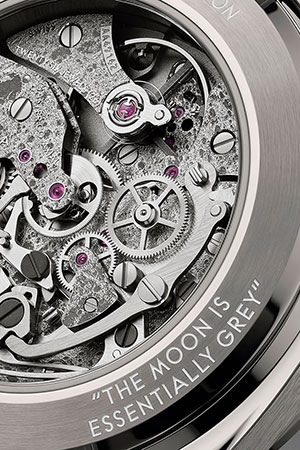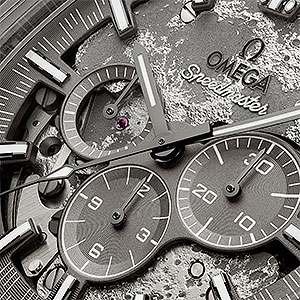October 14, 2025 — Omega, the Swiss watchmaker behind the first timepiece worn on the moon, is revisiting the "dark and grey sides" of Earth's celestial neighbor with seven new wristwatches, including a model inspired by one of the first humans to see the far side with his own eyes.
In 1968, while orbiting the moon with crewmates Frank Borman and Bill Anders, Apollo 8 astronaut Jim Lovell remarked that "the moon is essentially grey." His words have now been reprinted on the caseback of Omega's new "Speedmaster Grey Side of the Moon" watch.
The 44.25 mm chronograph features a laser-ablated lunar surface visible on both the front and back of the timepiece, looking through the Calibre 3869 movement. The near side of the moon is modeled between the watch's skeletonized grey dial, while the far side can be seen through its transparent caseback.
Like the Speedmaster worn on the moon, the face of the Grey Side of the Moon includes three subdials: a small-seconds display at the 9-hour mark, a 30-minute recorder at the 3-hour mark and a 12-hour recorder at six hours.
The $16,400 Speedmaster Grey Side of the Moon is offered in two models, differing by either a grey rubber or coated nylon strap. The rubber strap continues the lunar motif with the surface detail molded into the material.
The five other new Speedmasters expand on Omega's "Dark Side of the Moon" collection.
"All models now feature improved case proportions with slimmer profiles while maintaining the bold 44.25mm presence that defines the Dark Side aesthetic," Omega described in a press release.
The models include a reworked version of the original Dark Side of the Moon, as first introduced by Omega in 2013, and the much slimmer, manual-winding Black Edition, featuring a red central chronograph hand and full matte dial.
There is also a new Black Edition model with darkened movement components and enamel tachymeter scale.
The Dark Side of the Moon watches range from $15,700 to $16,100 with a choice of rubber or nylon straps.
The terms "grey" and "dark" to describe sides of the moon is used by Omega as model titles. The moon only has near and far sides, due to it being gravitationally locked — it takes the same amount of time to rotate on its axis as it does to orbit Earth. As a result, the moon always shows the same side, or near side, to Earth.
The former Soviet Union returned the first views of the far side when its Luna 3 probe captured photographs on Oct. 7, 1959. American astronauts Lovell, Borman and Anders were the first humans to see the far side firsthand nine years later.
China was the first country to land a spacecraft and rover, Chang'e 4, on the far side of the moon in 2019. NASA is now preparing to launch its Artemis II crew on the first mission to fly by the far side of the moon in more than 50 years.
Omega's Dark Side of the Moon collection was previously updated for the 50th anniversary of the Apollo 8 mission in 2018 and then again in 2024 to include a subdial hand in the shape of NASA's Saturn V rocket. The latter "Apollo 8" model remains available ($16,100) along with the new Dark Side of the Moon variations. |
|

The transparent caseback of the new Omega Speedmaster Grey Side of the Moon wristwatch is inscribed on the bezel with Apollo 8 astronaut Jim Lovell's description of the lunar surface. (Omega)

Omega laser-ablated the dial of the Speedmaster Grey Side of the Moon to reproduce the appearance of the lunar surface. (Omega) |
